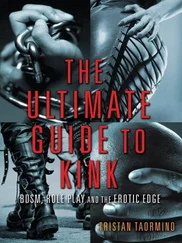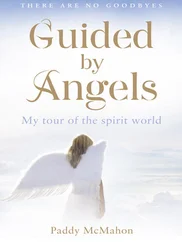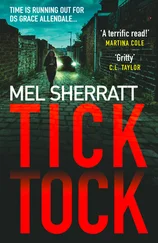Many of the Dielen shocked outsiders due to the casual, unsalacious atmosphere. They were just bare bones pick-up bars—dimly lighted joints for queers with beers. More gratifying to tourist tastes, of course, were lounges that featured human displays of Berlin exotica; “Café Monbijou” and the “Dé Dé” both adorned their cabaret platforms with naked hermaphrodites, who did nothing more than nonchalantly smoke and smile wanly from their elevated chairs. The “Lion Cub” Diele , which was decked out as a Wild West saloon, offered interactive delights. The pumped-up waiters, or “cubs,” were attired in sailor or butcher-boy dress. On the menu was a extensive list of international beers and the names of the service staff. For just a few pfennig more, one could cop a sensuous feel from the biceps or hairless chest of a lusty Bube .
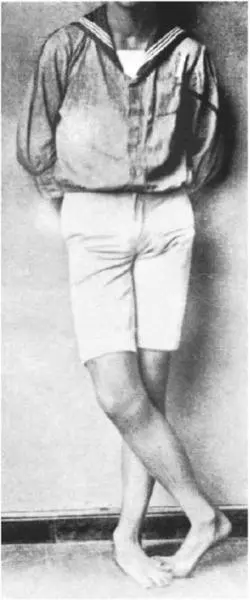
Amateur photo, The White Linen Shorts
Other gay amusement sites restricted their paying guests to an identifiable clientele or ones adhering to a special dress code, like elderly, fat men who dressed in schoolboy’s knickers or tight-fitting sailor suits. The “Nürenberger Diele” and the “Kantdiele” catered exclusively to balding stockbrokers, who spent their picturesque evenings dancing with “elegant pansies.” At the swanky “Hollandaise” nightclub, homosexual couples appeared, at first, to be straight fashion-horses; the men in tuxes, their mates in understated velvet and pearls. Only at close listening range could an inexperienced observer unscramble the daunting gender puzzle.
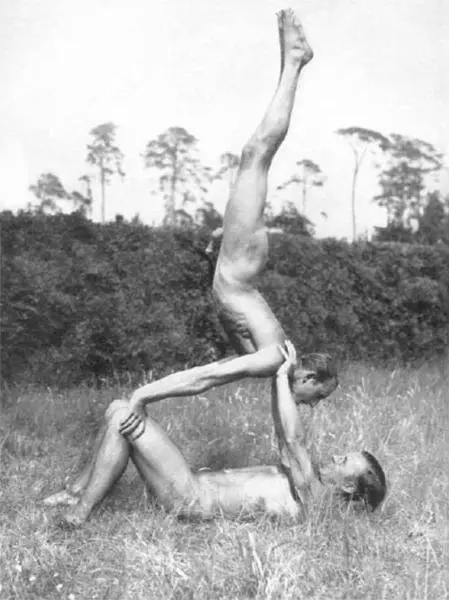
In the Field , 1928
Each Diele and ballroom had its little quirks and protocols. Isherwood immortalized one of them, the “Cosy Corner,” in his series of “Berlin Stories” and increasingly confessional memoirs. Between 1929 and 1933, the expatriate Isherwood became obsessed with the bar and its denizens. He talked about it in London and Paris, wrote about it, and made it the first point of interest for his queer colleagues touring Berlin. Even the incorrigible bisexual occultist Aleister Crowley was dragged there by Isherwood. Within a moment of entering the Cosy Corner, the “wickedest man in the world” walked up to one of the open-shirted Bubes and clawed the boy’s chest with his razor-sharp talons. A horrified Isherwood immediately persuaded Crowley to offer the tough some money before they made a fast getaway. On the street, both were relieved; Isherwood because his quick thinking prevented a retaliatory assault, and Crowley because he made his indelible mark on the “City of Satan.”■
Lesbian emotional needs are truly inordinate. They build a world of their own—in their houses, in their lounges, in their literature, and especially in their love practices. Lesbian desires reel over stars, aromas, sounds, and luminous colors. Caresses of soft and pliant hands, nail and tooth, soft bites and pulling of hair, and finally, after great tension, an utter free-fall and drowning until their own egos are dissolved into a moment of measureless bliss.
Ruth Roellig,
Lesbians and Female Transvestites , 1929
“We are the New Spirit.
We do it with Brazenness.”
Sign above the ladies room in the Toppkeller, 1930
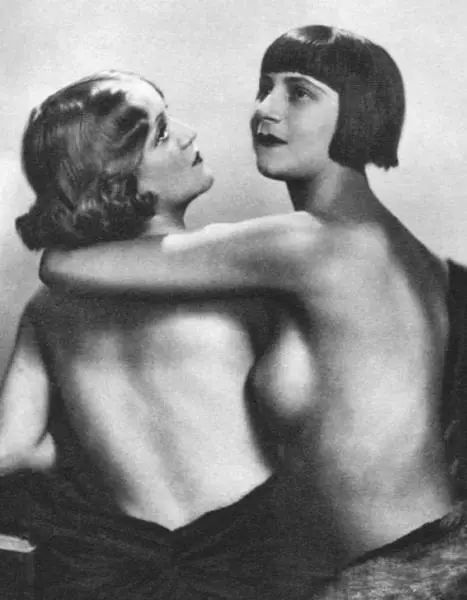
Margit Toth, Hot Sisters
Before the First World War, a rigid classification of lesbian types was already well established in the Central European mind. Frumpy, sexless aunts, monstrously ugly town gossips, and man-hating adventuresses—each understood to be a tribadic archetypal figure—appeared with some frequency in the popular fiction and stage melodrama of Berlin and Vienna. These images of unmarried females were repeated, with shocking naiveté, in widely-published psychological portraits that examined urban dementia and female criminology. Even among the new breed of sexologists, the spectrum of lesbian behavior was grossly delimited to the freakish, the misguided, and the intentionally perverse.
The characterology of non-heterosexual women followed a common delineation, beginning with the Constitutional Lesbian. A hormonally unbalanced matron, the Constitutional Lesbian was immediately recognized by her shapeless contours and unflattering mixed-gendered apparel. Depending on the grotesqueness of her body and degree of sexual inertia, she could be a harmless “Old Maid” or the trouble-making Tadpole , an embittered mannish concoction with facial hair and a destructive revolutionary disposition.
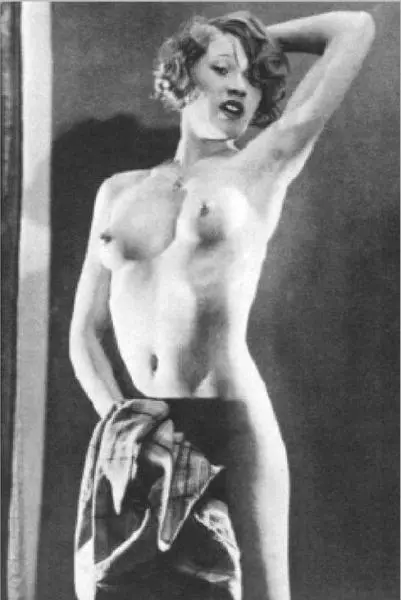
A Garçonne , 1928
BERLIN LESBIAN TYPES
BUBIS—Masculine, or butch women. Often wore male clothing, especially fedoras and leather ties. Recognized by their long leather coats in winter and ubiquitous cigars. Some Bubis sported delicately drawn “mustaches” (imitating Spanish aristocratic women). Reputed to be the best automobile drivers in Berlin. Attracted to Mädis , who referred to them as Daddies .
DODOS—Tuxedoed, sophisticated power women. Identified by their immaculately coiffed dark, curly hair, which hung loose, Gypsy style (called Titus-kopfs ). Their faces powdered ivory-white, they often wore horn-rimmed eyeglasses or monocles. Serious and ironic. Attracted to Garçonnes .
GAMINES—Pert, saucy femmes. Usually attired in exaggerated French street urchin clothing when clubbing.
GARÇONNES—Young women with Bubikopf haircuts and shaved, penciled-in eyebrows. Stylishly dressed in French male fashions. Had their own weekly magazine, Garçonne ; motto: “For Friendship, Love, and Sexual Enlightenment.” [Also known as BACHELORETTES or HANSIS.]
GIRL-FRIENDS—Generic name for homosexual women. [Variants: HOT SISTERS.]
GOUGNETTES—[From French underworld argot] Expensive lesbian callgirls, who appealed to both genders. Found in many lesbian clubs and fancy tourist hotels in the Friedrichstadt.
HOT WHORES—Heavily made-up professional prostitutes who serviced only female clients. Frequently seen on barstools in lesbian lounges, facing the dance floor with a vacant stare and long cigarette-holders in their hands. [Variant name: SALVATION ARMY GIRLS.]
MÄDIS—Ultrafemmes. [Variants: LADIES, LITTLE MEN, or SWEET MOMMIES.]
SHARPERS—Sexually aggressive but refined and socially well-positioned Bubis . Characterized by their androgynous “Diana” features. Exhibited a perverse taste for confused, working-class Mädis . A staple of lesbian romantic fiction. [Known as SCORPIONS in the Wilhelmian and Inflation periods.]
TADPOLES—Unattractive, career Bubis . Defined by their shapeless exteriors, mannish attire, and facial hair. Tadpole sexuality was often sublimated into progressive social causes and artistic pursuits.
A second variety, the Situational Lesbian, provided more hope for social redemption and visual appeal. This included young bourgeois women who, during their wayward adolescence, were cloistered away from normal social interaction with virile males. Those extended periods of female isolation (particularly in all-girl boarding schools or sinister nunneries) and exposure to the teachings of predatory lesbians were thought to pervert the girls’ natural inclination for heterosexual courtship and marital happiness. Petty female criminals and prostitutes as well were prey to sexual inversion due to long-term male mistreatment and a learned contempt for societal mores. (At least, these types could be saved with sympathetic instruction and the adornment of proper female attire.)
Читать дальше







